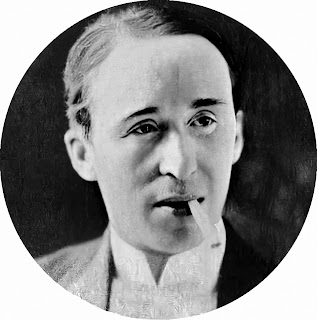To read the previous chapter of this essay on the work of director Robert Saidreau, click here.
Planchet
 |
| Armand Bernard |
It probably did not escape his notice, since he signs a three-film contract with an already well-established comedy director, to play adaptations of plays no less solid, none of which include a Planchet on the horizon, or even a character approaching. Thanks to Saidreau, Armand Bernard will never play "Planchet" on the screen again, even if this role will remain stuck to him in many articles after that. He is seen here kissing his effigy in a cinema hall for the photographer of Mon Ciné at the French press showing of The Prisoner of Zenda.
 |
| Armand Bernard kisses Planchet |
The Plot
My Aunt of Honfleur is therefore a successful play by Paul Gavault, of which Robert Saidreau has just adapted The Idea of Françoise, which appeared on the screens when on April 20, 1923 the upcoming filming of this new adaptation is announced. The subject is pure "boulevard": Armand Berthier (Armand Bernard) takes advantage of the financing of his studies by his aunt (Jeanne Loury) to live idle in Paris. One day, the aunt arrives and trouble begins. While Armand tries to exfiltrate a woman, Lucette (Irène Wells?), from his apartment without the aunt noticing, Albertine (Peggy Vère) knocks on the door.
Armand has promised his friend Adolphe Dorlange (Pierre Etechepare) to notify the young lady of the end of their union. She in turn convinces Armand to try to persuade Adolphe to come back to her. To do this, Armand will seduce the new girlfriend of his buddy, Yvonne (Mary Belson?) And the aunt will approve the union.In addition to yet another collaboration between Pierre Etchepare and Saidreau, we also notice the second and last with Mary Belson in a role identified on May 26, 1923 as being that of Lucette, which differs from imdb. And Jeanne Loury is here at the beginning of a long career of aunts and mothers at only 26 years old, that is to say much younger than Armand Bernard at the time.
The main cast is very advantageously surrounded by solid supporting roles and whose already established popularity will only grow: Marcel Vallée (the valet), Charles Martinelli (Adolphe's father), Louis Pré-Fils ( Doctor Douce) and Joffre. Four actors who had shared the screen with "Planchet" in The Three Musketeers.
Shooting
However Comoedia warns on May 31 that Planchet, before starting the exteriors, must still go to Bordeaux to play his sketch before filming the exteriors.Mon Ciné explains what it is: authors Georges de La Fouchardière and Félix Celval wrote a comedy sketch, "The Adventure of Planchet", which Rachel Devyris and Armand Bernard then play in 28 movie theaters in France, and in which Queen Anne of France pursues Planchet with her assiduity. The tour in Bordeaux and Biarritz is interrupted to complete the filming of Ma Tante d'Honfleur.
The exteriors were done in Bièvre, where Saidreau and Bernard studied the scenario lying on the grass.
It is on June 16 that Comoedia announces the end of the shooting of the interiors.
The release
Bonsoir published their review on November 18, 1923: "his filmed comedies treated with taste and intelligence have always entertained and held the attention of the public." In light of this success, the play will be adapted for the screen again in 1931 and 1949.Robert Saidreau has now become a director important enough for his quotes, like a classic author, to be reproduced with emphasis in large print on the sidelines of the Intransigeant articles which deal with his films: "It is more difficult to make people laugh than to make people cry. Let the man who is not imbued with this truth try to stage a comic film."
I do not know if it is by allergic or visionary sensitivity, but it seems that at the time, he was thinking about making a film where no one smokes. L'Intransigeant rose up on June 9: "Some people have all the nerve."; which gives an idea of the incongruity that an anti-smoking attitude could have been at the time.
To read the next chapter on the work of director Robert Saidreau, click here.
Click "Like" on the Facebook page if you like my blog.
That's all for today folks! See you soon !




